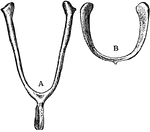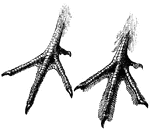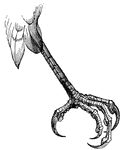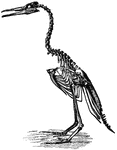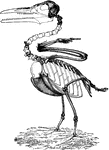The Bird Anatomy ClipArt gallery offers 411 illustrations of skeleton diagrams, arteries, digestive system, eggs, feathers, and both internal and external diagrams.

Skull of Common Fowl
"Typical Skull of Common Fowl (Galliformes). A, side view: sa, surangular bone of mandible; ar, articular…

Skull of Common Fowl
"Typical Skull of Common Fowl (Galliformes). B, vertical longitudinal section: sa, surangular bone of…

Egg Germination
"Further development of hen's egg; after Haeckel: A, the mulberry mass of cleavage cells, b, same as…

The Glottis of a Rook
"Glottis, or opening of trachea in the mouth; a, base of tongue; b, b, horns of hyoid bone; c, rima…
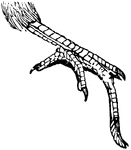
Foot of a Goat-Sucker
The foot of a goat-sucker, with a distinctively longer middle toe, believed to be used for either grasping…
Goose Hyoid
"Fig 72 - Hyoid bones of a goose, nat. size; Dr. R.W. Shufeldt, U.S.A. a, cartilaginous end-piece of…

Bill of Goose
"The beak or bill of birds is composed of two bony pieces, called mandibles, surrounded by a horny substance,…
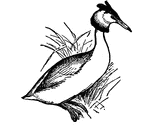
Great Crested Grebe
The Great Crested Grebe (Lophæthyia cristata) is a fresh-water, migratory, diving bird of the family…
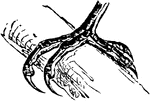
Foot of a Great Jacamar
The foot of a Great Jacamar, a bird belonging to the Scansores order. Scansores is an order of birds,…
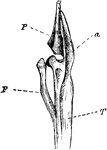
Leg Bones of a Grebe
"F. Fibula; T, tibia, with a, its cnemial process, and P, large patella, of a grebe." Elliot Coues,…
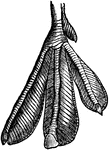
Foot of Grebe
"In this foot each toe is provided with its swimming membrane; the membrane being closed when the foot…
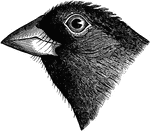
Blue Grosbeak Bill
"Guiraca. Blue Grosbeak. Bill Commissure strongly angulated far beyond base, with deep under mandible…
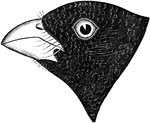
Song Grosbeak Bill
"Zamelodia. Song Grosbeak. Bill extremely heavy, with the lower mandible as deep as the upper or deeper,…

Ruffed Grouse Head
"Bonasa umbella. Ruffed Grouse. "Partridge;" "Pheasant;" Above, variegate reddish- or grayish-brown,…
The Pelvis of a Young Grouse
"Pelvis of a young grouse, showing three distinct bones. Il,P, ilium, ischium, pubis. In front of former…

The Wing Bones of a Young Grouse
"Fig. 29., from a young grouse (Centrocercus urophasianus, six months old), is designed to show the…

Californian Guillemot Bill
"Bill averaging somewhat longer, about 1.90; culmen, commissure, and gonys nearly straight; upper mandible…

Common Guillemot Bill
"Bill black; bill along culmen 1.75; gape 2.50; gonys 1.15; depth at base .55; width .30." Elliot Coues,…

Pigeon Guillemot Bill
"Uria columba. Pigeon Guillemot. Bill stouter than that of grylle, and more obtuse." Elliot Coues, 1884

Sooty Guillemot Bill
"Bill larger than Pigeon Guillemot, 1.5-1.70 along culmen, along gape 2.20, from feathers on side of…

Thick-billed Guillemot Bill
"Lomvia arra. Thick-billed Guillemot. Arrie. Bill short, stout, wide, deep; culmen curved throughout;…

Black Guillemot Bill
"Uria grylle. Black Guillemots. Bill much shorter than head, about equal to tarsus, straight, rather…
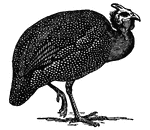
Guinea Fowl
Guinea Fowl are the African representatives of the pheasants, from which they differ in that the plumage…

Bustard Gular Pouch
"Gular pouch of bustard; a, tongue; b, the pouch, opening under a, hanging in front of c, the trachea,…

Gull Bill
The bill of the gull (Laridae) is epignathous: "hook-billed; having the end of the upper mandible decurved…

Laughing Gull Bill
"Chroicocephalus atricilla. Laughing Gull. Black-headed Gull. Bill longer than middle toe and claw,…
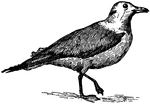
Kittiwake Gull
The Kittiwake gull (Rissa tridactyla) is a sea-gull characterized by the absence of the hind toe. It…

The Raptorial Foot of a Hawk
"Fig. 46. - Raptorial foot of a hawk, Accipiter cooperi. The raptorial is another modification of the…

The Superficial Muscles of a Hawk
In birds the muscles system is remarkable for their marked line of attachment to their tendons. Labels:…

Development of the Heart of a Chick
Heart of a chick at the 45th, 65th, and 85th hours of incubation. I, the venous trunks; 2, the auricle;…
The Foot of a Prairie Hen
"Cupidonia. Tarsi scant-feathered to the toes in front and on sides, bare on a strip behind; toes extensively…
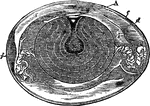
Hen's Egg
" Fig 110 - Hens egg, nat. size, in section; from Owen, after A. Thompson. A, cicatricle or "tread,"…

The Pelvis of a Heron
"Pelvis of a heron (ardea herodias), nat. size, viewed from below; from nature by Dr. R.W. Shufeldt,…
Hesperornis Lower Jaw
The lower jaw of the Hesperornis regalis, an ancient bird of the Cretaceous Period.
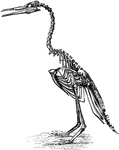
Restoration of Hesperornis regalis
"Hesperornis regalis, (a fossilized restoration) which stood about three feet high, had blunt teeth…
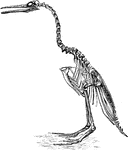
The Restoration of the Hesperornis Regalis
"Hesperornis regalis, (a fossilized restoration) which stood about three feet high, had blunt teeth…
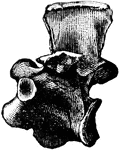
Hesperornis Vertebrae
A vertebrae of the Hesperornis regalis, an ancient bird of the Cretaceous Period.
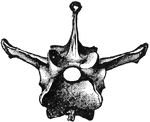
Hesperornis Vertebrae
A vertebrae of the Hesperornis regalis, an ancient bird of the Cretaceous Period.

Human Leg (Front View), and Comparative Diagrams showing Modifications of the Leg
This illustration shows a human leg (front view), and comparative diagrams showing modifications of…

The Hyoid-bone of a Rook
"Hyoid bone; a, glosso-hyal, tipped with cartilage, its posterior horn being certo-hyals proper; b,…

Skeleton Head of a Ichthyornis
"Ichthyornis victor and I. dispar, ...were small forms of about the size of a Partridge, with the habits…
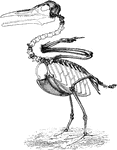
Restoration of Ichthyornis
"Ichthyornis, though the wings are well developed, with fused metacarpals, and the sternum is keeled,…

Intestine of a Chick
Rudiments of the liver on the intestines of a chick at the fifth day of incubation. Labels: 1, heart;…

Wing of Kamichi, or Crested Screamer
"The feathers are horny productions, consisting of a hollow tube or barrel and a stem rising from it."

Right Wing of Kestrel
"Right wing of the Kestrel, drawn from the specimen, while being held against the light."—Pettigrew,…
A Feather from the Tail of a Kingbird
"Fig. 23 - A feather from the tail of a kingbird, Tyrannus carolinensis, almost entirely pennaceous;…
